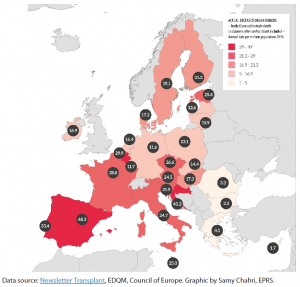Nowadays in Europe, the main source of transplantable organs is donations from donors after brain death, ahead of those from donors after circulatory death and from living donors. According to the European Commission’s 2017 study on the uptake and impact of the EU action plan on organ donation and transplantation (2009-2015) in the EU Member States, deceased donation is a source for kidney, liver, heart, lung, pancreas and small bowel transplants. Living donation is mainly performed for kidney transplants and some liver transplants. Demand for organs exceeds the number of organs available. In 2018, over 150 000 patients in Europe were registered on organ waiting lists. Organ donation rates for both deceased and living donation vary widely across the EU. In 2018, the number of actual deceased donors ranged from 48.3 per million people in Spain, 40.2 per million in Croatia and 33.4 per million in Portugal, to 0.5 per million in Romania (see Figure 1). Living organ donation practices vary, too. In a 2013 online survey, large discrepancies were found between geographical regions of Europe (eastern, Mediterranean and north-western).
Actual deceased organ donors 2018 (annual rate per million population)
Categories:
Related Articles
Visit the European Parliament page on
Visit the European Parliament page on
We write about
RSS Link to Scientific Foresight (STOA)
RSS Link to Members’ Research Service
Blogroll
Disclaimer and Copyright statement
The content of all documents (and articles) contained in this blog is the sole responsibility of the author and any opinions expressed therein do not necessarily represent the official position of the European Parliament. It is addressed to the Members and staff of the EP for their parliamentary work. Reproduction and translation for non-commercial purposes are authorised, provided the source is acknowledged and the European Parliament is given prior notice and sent a copy.
For a comprehensive description of our cookie and data protection policies, please visit Terms and Conditions page.
Copyright © European Union, 2014-2019. All rights reserved.








Be the first to write a comment.